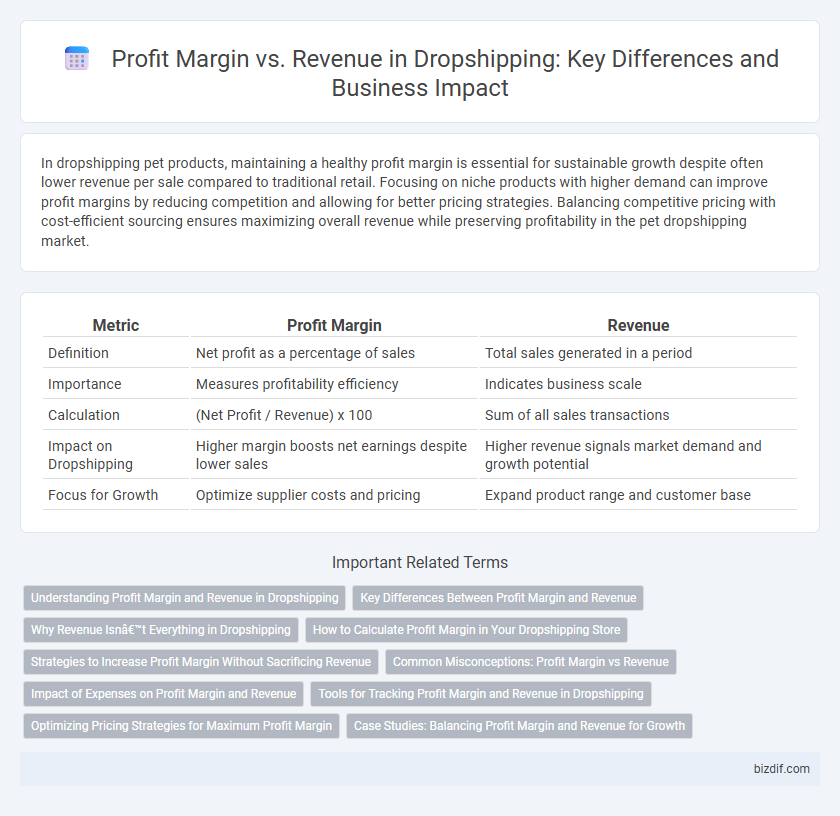In dropshipping pet products, maintaining a healthy profit margin is essential for sustainable growth despite often lower revenue per sale compared to traditional retail. Focusing on niche products with higher demand can improve profit margins by reducing competition and allowing for better pricing strategies. Balancing competitive pricing with cost-efficient sourcing ensures maximizing overall revenue while preserving profitability in the pet dropshipping market.
Table of Comparison
| Metric | Profit Margin | Revenue |
|---|---|---|
| Definition | Net profit as a percentage of sales | Total sales generated in a period |
| Importance | Measures profitability efficiency | Indicates business scale |
| Calculation | (Net Profit / Revenue) x 100 | Sum of all sales transactions |
| Impact on Dropshipping | Higher margin boosts net earnings despite lower sales | Higher revenue signals market demand and growth potential |
| Focus for Growth | Optimize supplier costs and pricing | Expand product range and customer base |
Understanding Profit Margin and Revenue in Dropshipping
Profit margin in dropshipping represents the percentage of revenue that remains as profit after subtracting all costs, including product acquisition, marketing, and shipping expenses. Revenue refers to the total income generated from sales before any expenses are deducted, providing a measure of business scale rather than profitability. Understanding the relationship between profit margin and revenue is crucial for optimizing pricing strategies and ensuring sustainable growth in dropshipping operations.
Key Differences Between Profit Margin and Revenue
Profit margin represents the percentage of revenue that remains as profit after deducting all expenses, reflecting the efficiency and profitability of dropshipping operations. Revenue denotes the total income generated from sales before any costs are subtracted, serving as a top-line indicator of business performance. Understanding the distinction between these metrics is critical for dropshipping businesses to optimize pricing strategies and manage operational costs effectively.
Why Revenue Isn’t Everything in Dropshipping
High revenue in dropshipping can be misleading if profit margins are thin, as increased sales volume may not translate to increased profitability. A strong focus on optimizing profit margins by controlling costs, sourcing efficient suppliers, and reducing overhead ensures sustainable business growth. Prioritizing profit over mere revenue helps dropshippers reinvest in marketing and inventory, ultimately driving long-term success.
How to Calculate Profit Margin in Your Dropshipping Store
To calculate profit margin in your dropshipping store, subtract the total cost of goods sold (including product, shipping, and transaction fees) from the total sales revenue, then divide by the total sales revenue and multiply by 100 to get a percentage. A higher profit margin indicates better profitability, helping you assess pricing strategies and operational efficiency. Tracking profit margin regularly ensures sustainable growth and informed decision-making for your dropshipping business.
Strategies to Increase Profit Margin Without Sacrificing Revenue
Optimizing profit margin in dropshipping requires strategic pricing, supplier negotiation, and cost-effective marketing to boost revenue while maintaining healthy margins. Leveraging data analytics to identify high-margin products and streamlining order fulfillment processes reduces operational costs without lowering sales volume. Focusing on customer retention through excellent service and upselling enhances lifetime value, driving profit growth alongside sustained revenue streams.
Common Misconceptions: Profit Margin vs Revenue
Many dropshipping entrepreneurs confuse revenue with profit margin, mistakenly believing high sales equate to high profitability. Revenue represents total income from sales, while profit margin reflects the percentage of revenue remaining after all expenses, including product costs, shipping, and marketing. Understanding this distinction is crucial for accurately assessing business performance and making informed financial decisions.
Impact of Expenses on Profit Margin and Revenue
In dropshipping, the profit margin is significantly affected by operational expenses such as shipping fees, marketing costs, and platform charges, which directly reduce net earnings despite high revenue figures. High revenue might create an illusion of success, but if expenses are not controlled, the profit margin remains slim or negative. Effective cost management and supplier negotiation are crucial to enhance profit margins while maintaining or increasing revenue.
Tools for Tracking Profit Margin and Revenue in Dropshipping
Effective tools for tracking profit margin and revenue in dropshipping include platforms like Shopify Analytics, Oberlo, and QuickBooks, which provide real-time insights into sales performance and cost management. These tools help dropshippers monitor gross profit margins by calculating the difference between revenue and product costs, enabling better pricing strategies and inventory decisions. Integrating tracking software with supplier data ensures accurate revenue reporting and improves financial forecasting for sustainable business growth.
Optimizing Pricing Strategies for Maximum Profit Margin
Optimizing pricing strategies in dropshipping directly influences profit margins by balancing competitive pricing with product costs and market demand. Tracking key metrics such as cost of goods sold (COGS), shipping fees, and competitor pricing allows for dynamic price adjustments that maximize revenue without sacrificing margin. Implementing tiered pricing, bundle offers, and psychological pricing techniques enhances perceived value, driving higher sales volumes and boosting overall profitability.
Case Studies: Balancing Profit Margin and Revenue for Growth
Case studies reveal that successful dropshipping businesses prioritize balancing profit margin and revenue to sustain growth. Higher revenue with thin profit margins can drive market share but may risk cash flow challenges, whereas optimizing margins ensures profitability but might limit scalability. Data from leading dropshipping platforms demonstrate that achieving a strategic equilibrium between these financial metrics is crucial for long-term business viability.
Profit margin vs revenue Infographic

 bizdif.com
bizdif.com